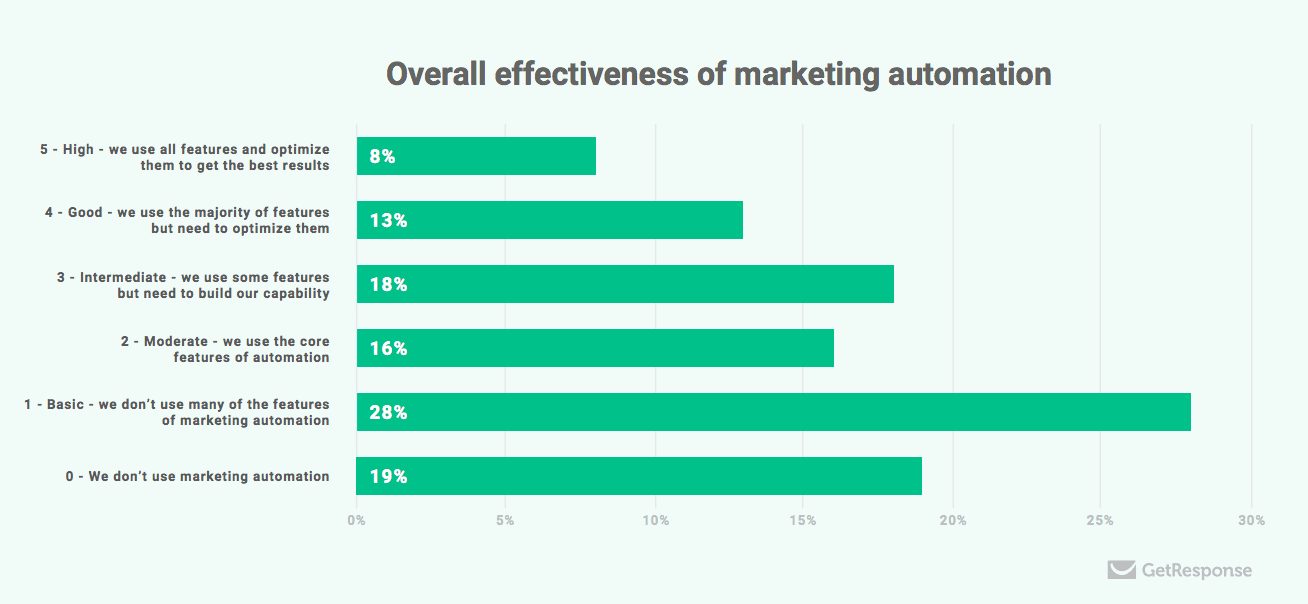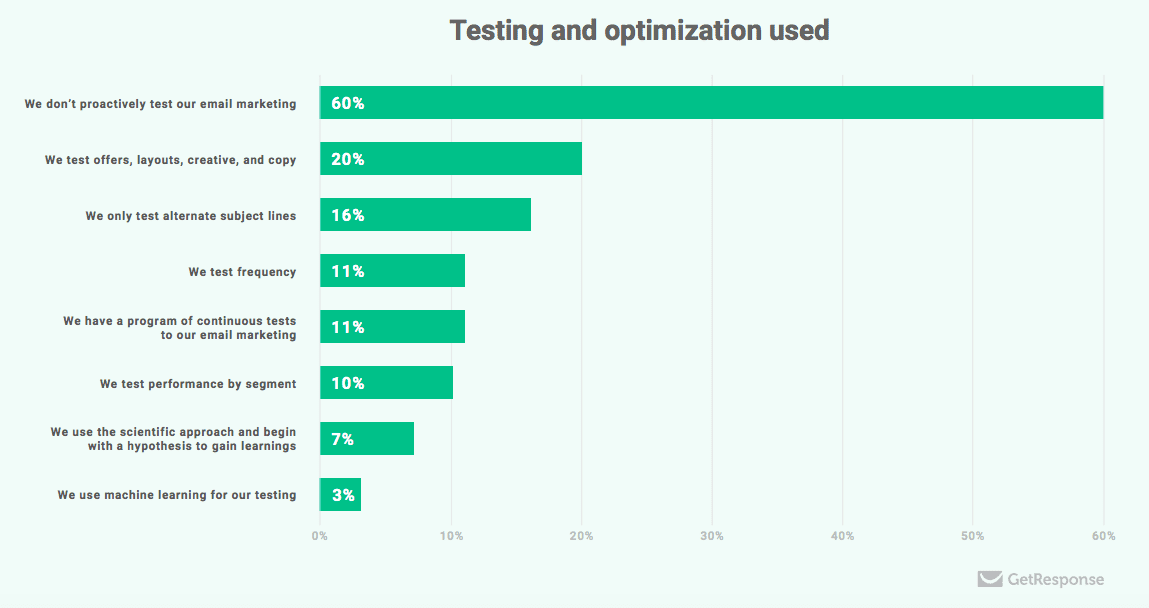See the latest email marketing and automation statistics to help benchmark your current performance and plan improvements
We’ve recently updated our State of email marketing report, Email Marketing and Marketing Automation Excellence report 2018, in partnership with GetResponse. This year’s report shares some interesting findings from an analysis based on over 500 respondents working in a senior position across B2C, B2B or both.
Use our findings to help benchmark your current performance and map digital improvements. Throughout the report, we highlight the features businesses should try and start implementing straight away, whilst exploring how current marketing automation is used in the industry. The report covers a range email marketing and automation results, challenges and use of features, including:
- Investment in Email Marketing
- Evaluation and tracking
- Targeting
- Communication strategy
- Testing and optimization
- Open and CTRs based on industry
- Lead generation
Read our summary below, or download the full report today, for free.
Report findings:
- Businesses are investing more in email marketing than in other channels. Only 4% of respondents said their email marketing budget was decreasing. Almost half (47%) expected an increase in their budget, while 33% said it would stay the same.
- Just 5% of respondents say they’re experts, while the majority rate themselves as Basic or Intermediate. This is understandable, as email marketing is complex and constantly evolving.
How effective is email marketing today?
There are a lot of debates on industry-leading blogs and expert opinions regarding the digital channel that provides the highest ROI or most effective channel for business goals. Email marketing has arguably shown, in previous research, that it is a high driver of sales and engagement, and when utilized correctly with a full range of its features it can be a great channel to nurture prospects into buying customers, cross-sell best-performing products, and encourage repeat sales from engaged customers and brand advocates.
Email marketing forms part of the ‘Engage’ phase of Smart Insights’ RACE planning framework. Customer onboarding and campaign emails can drive sales and increase ROI, whilst also engaging loyal customers and re-engage lapsed customers through a personalized program.
The RACE planning system will help you create an integrated strategy for content and customer engagement across all digital channels.
Need help with your digital marketing strategy?
We have a range of resources to help you plan, manage and optimize your digital marketing strategy and help integrate your email marketing and marketing automation into a wider digital campaign.
Our report shows that respondents also agree email marketing provides the best ROI. Around 2 in 10 (18%) said email was “excellent” for ROI, and almost 3 in 10 (29%) rated it as “good”. Compared to other channels, email scored highest for excellent ROI.
Compared to last year’s report, social media and content marketing ROI were higher, and organic SEO remained strong.
2018 Email Marketing budget
Almost half (47%) expect to spend more on email marketing compared to last year – and compared to all other channels. Of those whose budgets will stay the same, email marketing will still get the biggest slice of the pie (33%), with the biggest drop in investment reported for direct mail at 9%.
Email marketing and marketing automation capabilities
We asked our respondents to rate their marketing automation on a scale of 1-5 based on the features they use. Shockingly, 28% stated they only have a basic use of automation using very little features that it provides. 19% replied saying they don’t use marketing automation. Only 8% rated their marketing automation as excellent using all features and constantly opimizing to get the best results.
This is due to people rating themselves between beginner and having basic or intermediate knowledge. Only 5% call themselves experts. It seems that although marketers have email marketing skills, many have yet to advance their digital skills and try marketing automation missing big opportunities to convert prospects.
Evaluation and tracking
It’s standard to track the basic metrics of email performance: open rates and clicks, but these can be just vanity metrics that don’t correlate to lower funnel metrics. They’re quick to access and easy to analyze but don’t give very much value in the way of understanding deeper consumption habits and engagement. To get deeper insights into your email performance it is essential that you integrate your email platform with your website. Try tracking subscriber activity.
This year, we found more marketers (19%) are measuring mid-low funnel metrics compared to 15% in 2017. However, 28% don’t focus on any metrics at all and are more than likely missing out on possible data-driven improvements. There needs to be a balance between intuition and data-driven decisions in order to track and improve email campaigns. It is shocking to us that so many marketers aren’t delving into the data that can be accessed. This might be due to lack of time or lacks of skills and resource. Understanding email performance is essential!
If you need help digging digger into the data, we have an Email Marketing ROI calculator, which you can use to accurately access the number of responses from email channels, review email performance and review changes you need to make to improve your online marketing results.
Targeting, frequency, and optimization
Do you target your email communications based on customer segments? Have you considered the different segments in your database? Basic segmentation identifiers can go beyond common attributes such as demographics and delve into psychographic and behavioural characteristics. What consumers do online is more important than who they are or where they are. Segments can include:
- Psychographic (brand preference, price sensibility, attitudes, lifestyle, hobbies etc.)
- Behavioural (purchase history, internet use, channel preference etc.)
Rank these segments in order of importance to the business to understand the frequency of communications needed and the content you need to create. Targeted communications and tailored content will improve conversion rates.
The importance of targeting is why we’re so shocked to see 53% of companies have no targeting strategy for their emails. The more a company understands their customers and has the skills to use their email platform to send dynamic content and layered personalized targeting the higher ROI it’ll achieve. Only 4% say they use layered personalized targeting that combines demographics with behavioural segments, lifecycle position, activity level and lead scoring.
Our findings show that companies have a long way to go in the next year to reach a state of email excellence. Our capability grader can help benchmark your current email and marketing automation and provide recommendations on how to improve with strategic advice and actionable templates.
How often should you send an email? 32% send emails 2 to 3 times a day and 17% send emails only once a month. Those sending one email a month are potentially missing out on lead nurturing opportunities and sales, however, if you send too many your recipients many become numb to your marketing communications, or, even worse, you may gain a reputation for being a spammer. To improve relevance, use marketing automation to vary frequency by subscriber to make sure customers receive specific messages.
Throughout the report, we have found that many companies have only basic use of email and marketing automation and this is the same for testing. More than half (60%) don’t proactively test email marketing. 11% have a program of continuous tests, and only 3% use machine learning for testing. However, overall, those that do test their emails use a range of techniques to test a range of features:
- Segments
- Subject lines
- Creative and copy
Industry open and click rate
Consumers from all industries behave differently, open and CTRs differ depending on the industry – benchmark your performance against our findings:
Want to access more findings? Download our free report!








